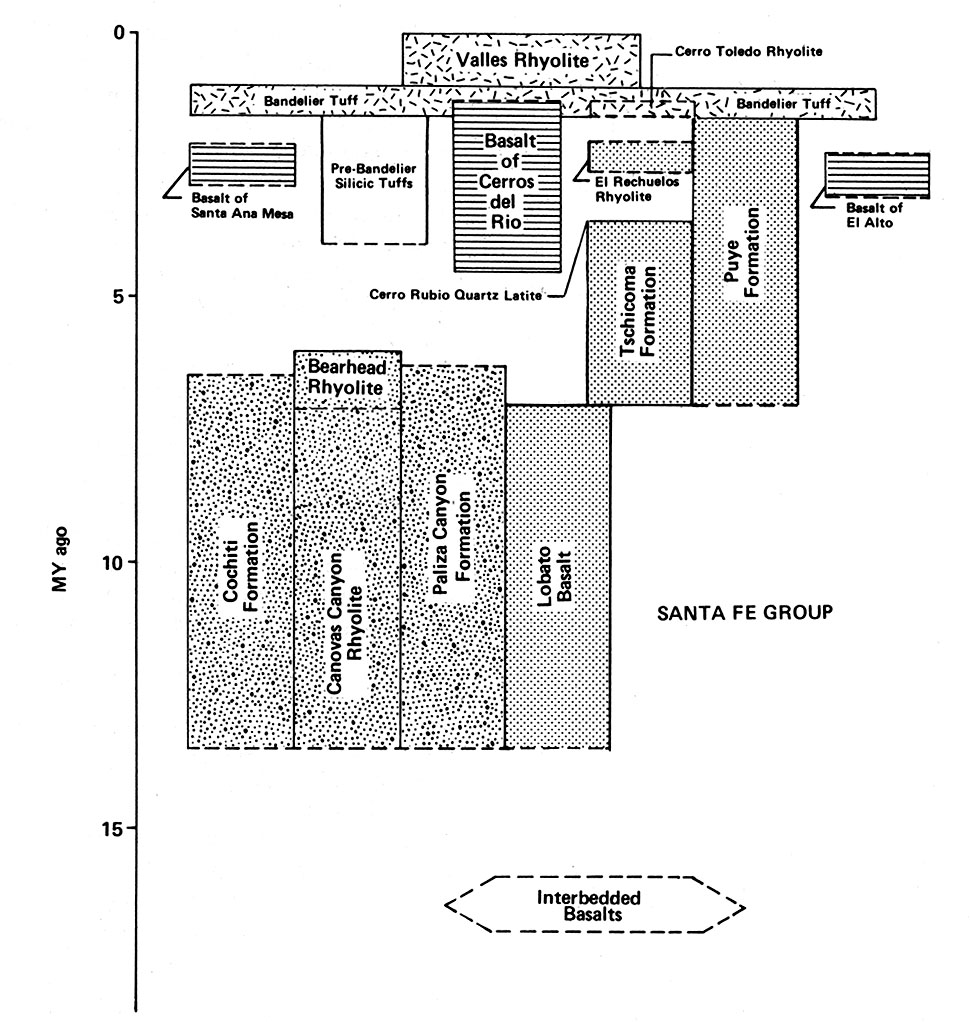
BEDROCK AND ALLUVIAL DEPOSITION OF THE SIERRA DE LOS VALLES
Due to continuing tectonic stress along the Rio Grande, a lineament down into the mantle has produced a great amount of mafic volcanism during the last 13 million years (Self et al. 1986). Similar to the Mount Taylor field to the west, earlier eruptive events during the Tertiary more likely related to the complex interaction of the Basin and Range and Colorado Plateau provinces produced bimodal andesite-rhyolite fields, of which the Paliza Canyon (Keres Group) and probably the Polvadera Group (El Rechuelos) is a part (Broxton et al. 1995; Shackley 1998c; Smith et al. 1970; Figure 3.11 here). While both these appear to have produced artifact quality obsidian, the nodule sizes are relatively small due to hydration and devitrification over time (see Hughes and Smith 1993; Shackley 1990, 1998b). Later, during rifting along the lineament and other processes not well understood, first the Toledo Caldera (ca. 1.45 Ma) and then the Valles Caldera (1.12 Ma) collapsed causing the ring eruptive events that were dominated by crustally derived silicic volcanism and dome formation (Self et al. 1986). The later eruptive sequence of the Valle Grande Member is significant for the prehistoric procurement of the obsidian as discussed below. The Cerro Toledo Rhyolite and Valle Grande Member obsidians are grouped within the Tewa Group due to their similar magmatic origins. The slight difference in trace element chemistry is probably due to evolution of the magma through time from the Cerro Toledo event to the Valle Grande events (see Hildreth 1981; Mahood and Stimac 1990; Shackley 1998b, 1998c; see Figure below). Given the relatively recent events in the Tewa Group, nodule size is large and hydration and devitrification minimal, yielding the best natural glass media for tool production in the Jemez Mountains.

Generalized stratigraphic relations of the major volcanic and alluvial units in the Jemez Mountains (from Gardner et al. 1986). Note the near overlapping events at this scale for the Cerro Toledo and Valles Rhyolite members, and the position of Cerro Toledo Rhyolite at the upper termination of the Puye Formation.
Some of the potentially minor sources of archaeological obsidian from the Jemez Mountain area such as the glass from the Bland Canyon area, appear to be better artifact quality obsidian than previously reported. My recent survey in Bland Canyon (August 1999) below the Bearhead Rhyolite yielded a sample of over 100 marekenites of which a sample of 15 analyzed matched the Cerro Toledo Rhyolite signature, not the "Bland Canyon/Apache Tears" signature reported by Glascock et al. (1999:Table 1). The exact sampling location for the Glascock et al. (1999) samples is apparently unknown (see also Wolfman 1994). The Bland Canyon data reported could be rare nodules from an earlier eruptive event contemporaneous with the pre-caldera Polvadera Group, since obliterated by subsequent volcanism and thus nodules are rarely recovered. While this discrepancy could be sampling error in this study, it certainly suggests by this research that the eruptive history and trace element chemistry of artifact quality obsidian from the Jemez Mountains is somewhat more complex than originally described and warrants more intensive geoprospection.
![]() Back to SW Obsidian Sources page
Back to SW Obsidian Sources page
Revised: 21 March 2015